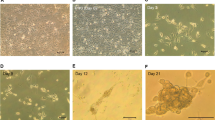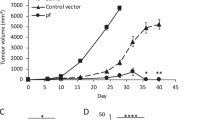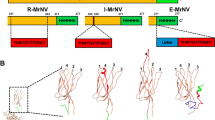Abstract
Non-human adenovirus vectors have attractive immunological properties for gene therapy but are frequently restricted by inefficient transduction of human target cells. Using chicken embryo lethal orphan (CELO) virus, we employed a nongenetic mechanism of polymer coating and retargeting with basic fibroblast growth factor (bFGF-pc-CELOluc), a strategy that permits efficient tropism modification of human adenovirus. bFGF-pc-CELOluc showed efficient uptake and transgene expression in chick embryo fibroblasts (CEF), and increased levels of binding and internalization in a variety of human cell lines. Transgene expression was also greater than unmodified CELOluc in PC-3 human prostate cells, although the specific activity (RLU per internalized viral genome) was decreased. In CEF, the specific activity of bFGF-pc-CELOluc was considerably higher than in the human prostate cell line PC-3. Retargeted virus was fully resistant to inhibition by human serum with known adenovirus-neutralizing activity in vitro, while in mice CELOluc was cleared less rapidly from the blood than Adluc following i.v. administration in the presence of adenovirus neutralizing serum. Polymer coating and retargeting with bFGF further reduced rates of clearance for both viruses, suggesting protection against both neutralizing and opsonizing factors. The data indicate that CELO virus may be retargeted to infect human cells via alternative, potentially disease-specific, receptors and resist the effects of pre-existing humoral immunity.
This is a preview of subscription content, access via your institution
Access options
Subscribe to this journal
Receive 12 print issues and online access
$259.00 per year
only $21.58 per issue
Buy this article
- Purchase on Springer Link
- Instant access to full article PDF
Prices may be subject to local taxes which are calculated during checkout








Similar content being viewed by others
References
Bergelson JM, Cunningham JA, Drouguett G, Kurt-Jones EA, Krithivas A, Hong JS et al. Isolation of a common receptor for coxsackie B viruses and adenoviruses 2 and 5. Science 1997; 275: 1320–1323.
Bergelson JM . Receptors mediating adenovirus attachment and internalisation. Biochem Pharmacol 1999; 57: 975–979.
Wickham TJ, Mathias P, Cheresh DA, Nemerow GR . Integrins αvβ3 and αvβ5 promote adenovirus internalisation but not virus attachment. Cell 1993; 73: 309–319.
Chirmule N, Propert K, Magosin S, Qian Y, Qian R, Wilson J . Immune responses to adenovirus and adeno-associated virus in humans. Gene Therapy 1999; 6: 1574–1583.
Stallwood Y, Fisher KD, Gallimore PH, Mautner V . Neutralisation of adenovirus infectivity by ascitic fluid from ovarian cancer patients. Gene Therapy 2000; 7: 637–643.
Zheng B, Mittal SK, Graham FL, Prevec L . The E1 sequence of bovine adenovirus type 3 and complementation of human adenovirus type 5 E1A function in bovine cells. Virus Res 1994; 31: 163–186.
Mittal SK, Prevec L, Graham FL, Babiuk LA . Development of a bovine adenovirus type 3-based expression vector. J Gen Virol 1995; 76: 93–102.
Reddy PS, Idamakanti N, Chen Y, Whale T, Babiuk LA, Mehtali M et al. Replication-defective bovine adenovirus type 3 as an expression vector. J Virol 1999; 73: 9137–9144.
Moffatt S, Hays J, HogenEsch H, Mittal SK . Circumvention of vector-specific neutralizing antibody response by alternating use of human and non-human adenoviruses: implications in gene therapy. Virology 2000; 272: 159–167.
Baxi MK, Deregt D, Robertson J, Babiuk LA, Schlapp T, Tikoo SK . Recombinant bovine adenovirus type 3 expressing bovine diarrhoea virus glycoprotein E2 induces an immune response in cotton rats. Virology 2000; 278: 234–243.
Baxi MK, Robertson J, Babiuk LA, Tikoo SK . Mutational analysis of early region 4 of bovine adenovirus type 3. Virology 2001; 290: 153–163.
van Olphen AL, Mittal SK . Development and characterisation of bovine × human hybrid cell lines that efficiently support the replication of both wild-type bovine and human adenoviruses and those with E1 deleted. J Virol 2002; 75: 5882–5892.
Wu QH, Tikoo SK . Altered tropism of recombinant bovine adenovirus type-3 expressing chimeric fiber. Virus Res 99; 1: 9–15.
Renaut L, Colin M, Leite JP, Benko M, D’Halluin JC . Abolition of hCAR-dependent cell tropism using fibre knobs of atadenovirus serotypes. Virology 2004; 321: 189–204.
Vrati S, Macavoy ES, Xu ZZ, Smole C, Boyle DB, Both GW . Construction and transfection of ovine adenovirus genomic clones to rescue modified viruses. Virology 1996; 220: 200–203.
Xu ZZ, Hyatt D, Boyle DB, Both GW . Construction of ovine adenovirus recombinants by gene insertion or deletion of related terminal region sequences. Virology 1997; 230: 62–71.
Hofmann C, Loser P, Cichon G, Arnold W, Both GW, Strauss M . Ovine adenovirus vectors overcome pre-existing humoral immunity against human adenoviruses in vivo. J Virol 1999; 73: 6930–6936.
Xu ZZ, Nevels M, MacAvoy ES, Lockett LJ, Curiel D, Dobner T et al. An ovine adenovirus vector lack transforming ability in cells that are transformed by Ad5 E1A/B sequences. Virology 2000; 270: 162–172.
Loser P, Hillgenberg M, Arnold W, Both GW, Hofmann C . Ovine adenovirus vectors mediate efficient gene transfer to skeletal muscle. Gene Therapy 2000; 7: 1491–1498.
Lockett LJ, Both GW . Complementation of a defective human adenovirus by an otherwise incompatible ovine adenovirus recombinant carrying a functional E1A gene. Virology 2002; 294: 333–341.
Kumin D, Hofmann C, Rudolph M, Both GW, Loser P . Biology of ovine adenovirus infection of non-permissive cells. J Virol 2002; 76: 10882–10893.
Voeks D, Martiniello-Wilks R, Madden V, Smith K, Bennetts E, Both GW et al. Gene therapy for prostate cancer delivered by ovine adenovirus and mediated by purine nucleoside phosphorylase and fludarabine in mouse models. Gene Therapy 2002; 9: 759–768.
Glasgow JN, Both GW, Krasnykh VN, Curiel DT . A chimeric adenovirus vector expressing an ovine adenovirus fiber has CAR-independent tropism. Mol Ther 2003; 7: 498.
Martinello-Wilks R, Dane A, Voeks DJ, Jeyakumar G, Mortensen E, Shaw JM et al. Gene-directed enzyme prodrug therapy for prostate cancer in a mouse model that imitates the development of human disease. J Gene Med 2004; 6: 43–54.
Both GW . Ovine atadenovirus: a review of its biology, biosafety profile and application as a gene delivery vector. Immunol Cell Biol 2004; 82: 189–195.
Farina SF, Gao GP, Xiang ZQ, Rux JJ, Burnett RM, Alvira MR et al. Replication-defective vector based on a chimpanzee adenovirus. J Virol 2001; 75: 11603–11613.
Cohen CJ, Xiang ZQ, Gao GP, Ertl HC, Wilson JM, Bergelson JM . Chimpanzee adenovirus CV-68 adapted as a gene delivery vector interacts with the coxsackie and adenovirus receptor. J Gen Virol 2002; 83: 151–155.
Roy S, Gao G, Lu Y, Zhou X, Lock M, Calcedo R et al. Characterization of a family of chimpanzee adenoviruses and development of molecular clones for gene transfer vectors. Hum Gene Ther 2004; 15: 519–530.
Klonjkowski B, Gilardi-Hebenstreit P, Hadchouel J, Randrianarison V, Boutin S, Yeh P et al. A recombinant E1-deleted canine adenoviral vector capable of transduction and expression of a transgene in human derived cells and in vivo. Hum Gene Ther 1997; 8: 2103–2115.
Soudais C, Boutin S, Hong SS, Chillon M, Danos O, Bergelson JF et al. Canine adenovirus type 2 attachment and internalisation: coxsackie-adenovirus receptor, alternative receptors and an RGD-independent pathway. J Virol 2000; 74: 10639–10649.
Soudais C, Laplace-Builhe C, Kissa K, Kremer EJ . Preferential transduction of neurons by canine adenovirus vectors and their efficient retrograde transport in vivo. FASEB J 2001; 15: U35–U57.
Chillon M, Kremer EJ . Trafficking and propagation of canine adenovirus vectors lacking a known integrin-interacting motif. Hum Gene Ther 2001; 12: 1815–1823.
Peltekian E, Garcia L, Danos O . Neurotropism and retrograde axonal transport of a canine adenovirus vector: a tool for targeting key structures undergoing neurodegenerative processes. Mol Ther 2002; 5: 25–32.
Hemminki A, Kanerva A, Kremer EJ, Bauerschmitz GJ, Smith BF, Liu B et al. A canine conditionally replicating adenovirus for evaluating oncolytic virotherapy in a syngeneic animal model. Mol Ther 2003; 7: 163–173.
Soudais C, Skander N, Kremer EJ . Long-term in vivo transduction of neurons throughout the rat central nervous system using novel helper-dependent CAV-2 vectors. FASEB J 2003; 17: U257–U276.
Glasgow JN, Kremer EJ, Hemminki A, Siegal GP, Douglas JT, Curiel DT . An adenovirus vector with a chimeric fiber derived from canine adenovirus type 2 displays novel tropism. Virol 2004; 324: 103–116.
Michou AI, Lehrmann H, Saltik M, Cotten M . Mutational analysis of the avian adenovirus CELO, which provides a basis for gene delivery vectors. J Virol 1999; 73: 1399–1410.
Tan PK, Michou AI, Bergelson JM, Cotten M . Defining CAR as a cellular receptor for the avian adenovirus CELO using a genetic analysis of the two viral fibre proteins. J Gen Virol 2001; 82: 1465–1472.
Logunov DY, Illyinskaya GV, Cherenova LV, Verhovskaya LV, Shmarov MM, Chumakov PM et al. Restoration of p53 tumor-suppressor activity in human tumor cells in vitro and in their xenografts in vivo by recombinant avian adenovirus CELO-p53. Gene Therapy 2004; 11: 79–84.
Cherenova LV, Logunov DY, Shashkova EV, Shmarov MM, Verkhovskaya LV, Neugodova GL et al. Recombinant avian adenovirus CELO expressing the human interleukin-2: characterisation in vitro, in ovo and in vivo. Virus Res 2004; 100: 257–261.
Yates V, Fry D . Observations on a chick embryo lethal orphan (CELO) virus. Am J Vet Res 1957; 18: 657–660.
Li P, Bellett A, Parish C . DNA-binding proteins of chick embryo lethal orphan virus: lack of complementation between early proteins of avian and human adenoviruses. J Virol 1984; 65: 1817–1825.
Laver WG, Younghusband HB, Wrigley NG . Purification and properties of chick embryo lethal orphan virus (an avian adenovirus). Virology 1971; 45: 598–614.
Gelderblom H, Maiche-Lauppe I . The fibers of fowl adenoviruses. Arch Virol 1982; 72: 289–298.
Chiocca S, Kurzbauer R, Schffner G, Baker A, Mautner V, Cotton M . The complete DNA sequence and genomic organization of the avian adenovirus CELO. J Virol 1996; 70: 2939–2949.
Fisher KD, Stallwood Y, Green NK, Ulbrich K, Mautner V, Seymour LW . Polymer-coated adenovirus permits efficient retargeting and evades neutralising antibodies. Gene Therapy 2001; 8: 341–348.
Plotnikov AN, Schlessinger J, Hubbard SR, Mohammadi M . Structural basis for FGF receptor dimerization and activation. Cell 1999; 98: 641–650.
McFerrin JB, Adair B, Connor TJ . Adenovirus antigens (CELO, QBV, GAL). Am J Vet Res 1975; 36: 527–529.
Van Rooijen N, Kors N, van der Ende M, Dijkstra CD . Depletion and repopulation of macrophages in spleen and liver of rat after intravenous treatment with liposome-encapsulated dichloromethylene diphosphate. Cell Tissue Res 1990; 260: 215–222.
Miyazawa N, Crystal RG, Leopold PL . Adenovirus serotype 7 retention in a late endosomal compartment prior to cytosol escape is modulated by fiber protein. J Virol 2001; 75: 1387–1400.
Shayakhmetov DM, Li ZY, Ternovoi V, Gagger A, Ghatwan H, Lieber A . The interaction between the fiber knob domain and the cellular attachment receptor determines the intracellular trafficking route of adenoviruses. J Virol 2003; 77: 3712–3723.
Shashkova EV, Cherenova LV, Kazansky DB, Doronin K . Avian adenovirus vector CELO-TK displays anticancer activity in human cells and suppresses established murine melanoma tumors. Cancer Gene Ther 2005; 12: 617–626.
Doukas J, Hoganson DK, Ong M, Ying W, Lacey DL, Baird A et al. Retargeted delivery of adenoviral vectors through fibroblast growth fact receptors involves unique cellular pathways. FASEB J 1999; 13: 1459–1466.
Lehrmann H, Cotton M . Characterization of CELO virus proteins that modulate the pRb/E2F pathway. J Virol 1999; 73: 6517–6525.
Cussenot O, Berthon P, Berger R, Mowszowicz I, Faille A, Hojman F et al. Immortalization of human adult normal prostate epithelial cells by liposomes containing large T-SV40 gene. J Urol 1991; 146: 881–886.
Cussenot O, Berthon P, Cochand-Priollet B, Maitland NJ, Le Duc A . Immunocytochemical comparison of cultured normal epithelial prostatic cells with prostatic tissue sections. Exp Cell Res 1994; 214: 83–92.
Berthon P, Cussenot O, Hopwood L, Leduc A, Maitland NJ . Functional expression of SV40 in normal human epithelial and fibroblastic cells – differentiation pattern of non-tumorigenic cell lines. Int J Oncol 1995; 6: 333–343.
Murakami P, McCaman MT . Quantitation of adenovirus DNA and virus particles with the Pico Green fluorescent dye. Anal Biochem 1999; 274: 288.
Haase AT, Mautner V, Pereira HG . The immunogenicity of adenovirus structural proteins. J Immunol 1972; 108: 483–485.
Acknowledgements
We specially thank Sue Phipps, Elizabeth Hodgkins, Oliver Hayward and Sarah Hale for assistance with Ad5 production. We are especially grateful to Norman Maitland for supplying the PNT1a and PNT-2 prostate cell lines and for Matt Cotten for the CELO virus (AIM 46). Funding from the European Union framework V research grant supported this work.
Author information
Authors and Affiliations
Corresponding author
Rights and permissions
About this article
Cite this article
Stevenson, M., Boos, E., Herbert, C. et al. Chick embryo lethal orphan virus can be polymer-coated and retargeted to infect mammalian cells. Gene Ther 13, 356–368 (2006). https://doi.org/10.1038/sj.gt.3302655
Received:
Revised:
Accepted:
Published:
Issue Date:
DOI: https://doi.org/10.1038/sj.gt.3302655
Keywords
This article is cited by
-
Fully Detargeted Polyethylene Glycol-coated Adenovirus Vectors Are Potent Genetic Vaccines and Escape from Pre-existing Anti-adenovirus Antibodies
Molecular Therapy (2008)
-
Modification of Adenovirus Gene Transfer Vectors With Synthetic Polymers: A Scientific Review and Technical Guide
Molecular Therapy (2008)



